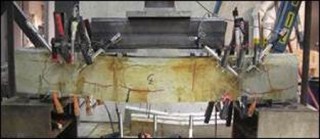Nov 23 2015
Reinforced concrete represents a very successful synergistic combination of materials not only mechanically but also chemically since concrete is a perfect material providing ideal environment with high alkalinity for the corrosion protection of steel reinforcement embedded in it although this is only valid when the concrete is designed properly to satisfy the covering purpose.
 Corroded reinforced conventional concrete beam (10% mass loss)
Corroded reinforced conventional concrete beam (10% mass loss)
The main problem regarding with the deterioration of reinforced concrete as a result of corrosion is not the reduced mechanical strength of reinforcement but rather the products of corrosion creating stresses within concrete that cannot be supported by the limited plastic deformation capability of concrete material itself leading to cracking and in extreme cases to structural breakdown followed by relatively lower service life than that of initially designed.
“This therefore brings about the idea of creating concrete material which will be resistant enough to endure considerable plastic deformations, have control over cracking behavior and be durable against several major durability issues including rebar corrosion” says Mustafa Þahmaran, Professor of Civil Engineering and Director of Advanced Cementitious Materials Research Laboratory in Gazi University, Ankara, Turkey.
Engineered Cementitious Composites - ECC which are designed based on the micro-mechanical design constraints were first proposed and invented by Professor Victor C. Li from University of Michigan, Ann Arbor. What separates ECC from traditional concrete material mostly being used in many civil engineering applications in the field is its strain hardening response under excessive tensile and shear loadings which is similar to many ductile metals.
The strain hardening behavior of ECC is a direct outcome of the formation of multiple microcracks having widths generally less than 100 micrometer threshold. “Although it seems unrealistic to produce a concrete material that is completely crack-free, with the control over cracking behavior many durability problems of reinforced concrete structures can be confronted” says Gürkan Yýldýrým, research assistant and Ph.D. candidate in Civil Engineering at Gazi University.
On the material basis, ECC already proved itself worthy in terms of freeze-thaw resistance, sulfate resistance, alkali-silicate resistivity, reinforcement corrosion and so on. However, compared to studies using small scale specimens, there are relatively less number of research papers aiming at the ECCs’ durability performance evaluation at large scale. Along these lines, Dr. Þahmaran and his lab team carried out a series of experiment to assess the effect of corrosion level on shear behavior of reinforced ECC and compared with conventional concrete.
According to the experimental findings compared to conventional concrete with similar strength grades, ECC beams exhibited significantly higher strength, stiffness, and energy absorption capacity, along with superior performance in terms of the restriction of damage caused by reinforcement corrosion. These performances of reinforced ECC (R/ECC) are expected to contribute substantially to improving infrastructure sustainability by reducing the amount of repair and maintenance during the service life of the infrastructure.
The research can be found in a paper titled “Effect of Corrosion on Shear Behavior of Reinforced Engineered Cementitious Composite Beams” published in the ACI Structural Journal.
For more information, contact:
Julie Webb
Marketing Communications Specialist
248-848-3148 FREE
[email protected]
Always Advancing – The American Concrete Institute is a leading authority and resource worldwide for the development and distribution of consensus-based standards and technical resources, educational programs and certifications for individuals and organizations involved in concrete design, construction and materials, who share a commitment to pursuing the best use of concrete. ACI’s inclusive, individual member-driven structure and valuable, cost-effective benefits result in an essential organization that invites partnerships and welcomes all concrete professionals who wish to be a part of a respected, connected social group that provides an opportunity for professional growth, networking and enjoyment. For additional information, visit www.concrete.org.